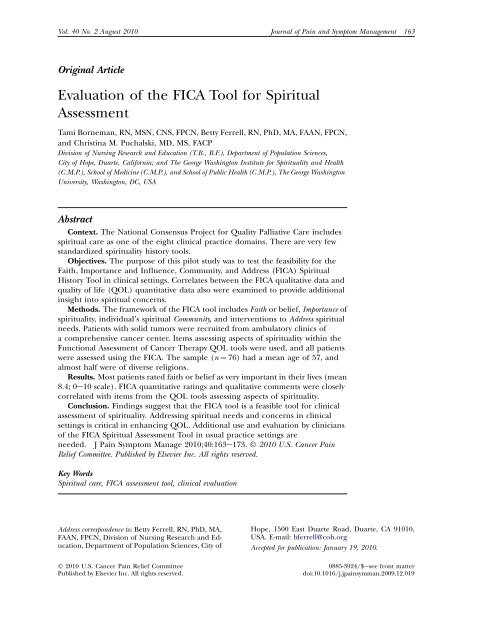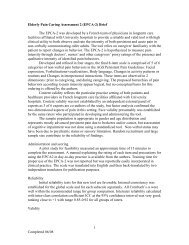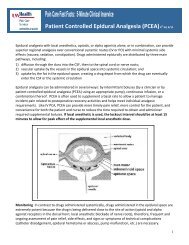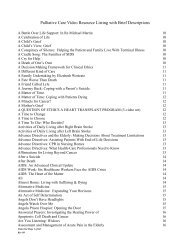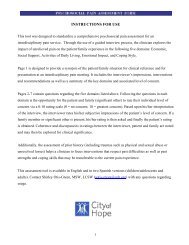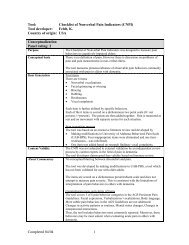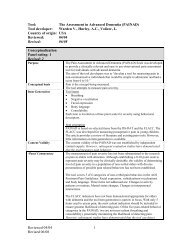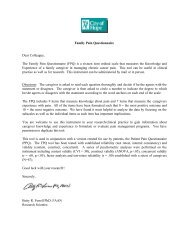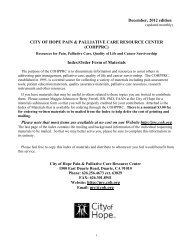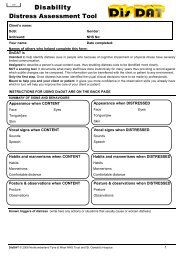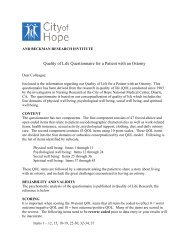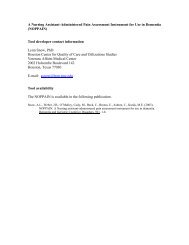Evaluation of the FICA Tool for Spiritual Assessment
Evaluation of the FICA Tool for Spiritual Assessment
Evaluation of the FICA Tool for Spiritual Assessment
- No tags were found...
Create successful ePaper yourself
Turn your PDF publications into a flip-book with our unique Google optimized e-Paper software.
Vol. 40 No. 2 August 2010 Journal <strong>of</strong> Pain and Symptom Management 163Original Article<strong>Evaluation</strong> <strong>of</strong> <strong>the</strong> <strong>FICA</strong> <strong>Tool</strong> <strong>for</strong> <strong>Spiritual</strong><strong>Assessment</strong>Tami Borneman, RN, MSN, CNS, FPCN, Betty Ferrell, RN, PhD, MA, FAAN, FPCN,and Christina M. Puchalski, MD, MS, FACPDivision <strong>of</strong> Nursing Research and Education (T.B., B.F.), Department <strong>of</strong> Population Sciences,City <strong>of</strong> Hope, Duarte, Cali<strong>for</strong>nia; and The George Washington Institute <strong>for</strong> <strong>Spiritual</strong>ity and Health(C.M.P.), School <strong>of</strong> Medicine (C.M.P.), and School <strong>of</strong> Public Health (C.M.P.), The George WashingtonUniversity, Washington, DC, USAAbstractContext. The National Consensus Project <strong>for</strong> Quality Palliative Care includesspiritual care as one <strong>of</strong> <strong>the</strong> eight clinical practice domains. There are very fewstandardized spirituality history tools.Objectives. The purpose <strong>of</strong> this pilot study was to test <strong>the</strong> feasibility <strong>for</strong> <strong>the</strong>Faith, Importance and Influence, Community, and Address (<strong>FICA</strong>) <strong>Spiritual</strong>History <strong>Tool</strong> in clinical settings. Correlates between <strong>the</strong> <strong>FICA</strong> qualitative data andquality <strong>of</strong> life (QOL) quantitative data also were examined to provide additionalinsight into spiritual concerns.Methods. The framework <strong>of</strong> <strong>the</strong> <strong>FICA</strong> tool includes Faith or belief, Importance <strong>of</strong>spirituality, individual’s spiritual Community, and interventions to Address spiritualneeds. Patients with solid tumors were recruited from ambulatory clinics <strong>of</strong>a comprehensive cancer center. Items assessing aspects <strong>of</strong> spirituality within <strong>the</strong>Functional <strong>Assessment</strong> <strong>of</strong> Cancer Therapy QOL tools were used, and all patientswere assessed using <strong>the</strong> <strong>FICA</strong>. The sample (n ¼ 76) had a mean age <strong>of</strong> 57, andalmost half were <strong>of</strong> diverse religions.Results. Most patients rated faith or belief as very important in <strong>the</strong>ir lives (mean8.4; 0e10 scale). <strong>FICA</strong> quantitative ratings and qualitative comments were closelycorrelated with items from <strong>the</strong> QOL tools assessing aspects <strong>of</strong> spirituality.Conclusion. Findings suggest that <strong>the</strong> <strong>FICA</strong> tool is a feasible tool <strong>for</strong> clinicalassessment <strong>of</strong> spirituality. Addressing spiritual needs and concerns in clinicalsettings is critical in enhancing QOL. Additional use and evaluation by clinicians<strong>of</strong> <strong>the</strong> <strong>FICA</strong> <strong>Spiritual</strong> <strong>Assessment</strong> <strong>Tool</strong> in usual practice settings areneeded. J Pain Symptom Manage 2010;40:163e173. Ó 2010 U.S. Cancer PainRelief Committee. Published by Elsevier Inc. All rights reserved.Key Words<strong>Spiritual</strong> care, <strong>FICA</strong> assessment tool, clinical evaluationAddress correspondence to: Betty Ferrell, RN, PhD, MA,FAAN, FPCN, Division <strong>of</strong> Nursing Research and Education,Department <strong>of</strong> Population Sciences, City <strong>of</strong>Ó 2010 U.S. Cancer Pain Relief CommitteePublished by Elsevier Inc. All rights reserved.Hope, 1500 East Duarte Road, Duarte, CA 91010,USA. E-mail: bferrell@coh.orgAccepted <strong>for</strong> publication: January 19, 2010.0885-3924/$esee front matterdoi:10.1016/j.jpainsymman.2009.12.019
164 Borneman et al.Vol. 40 No. 2 August 2010IntroductionOver <strong>the</strong> past 15 years, <strong>the</strong>re has been growinginterest in and attention to spiritual care asa dimension <strong>of</strong> palliative care and <strong>the</strong> association<strong>of</strong> spiritual or religious beliefs and healthcare outcomes such as quality <strong>of</strong> life (QOL), 1will to live, 2,3 depression, 4 and coping. 5 Implicitin <strong>the</strong> need to provide measurable patientoutcomes is <strong>the</strong> need to demonstrateworth <strong>of</strong> specific services. 6e8 The NationalConsensus Project <strong>for</strong> Quality Palliative Care(NCP) and <strong>the</strong> National Quality Forum determinedspirituality to be an essential element <strong>of</strong>care as described in Domain 5 <strong>of</strong> <strong>the</strong> NCPGuidelines: <strong>Spiritual</strong>, Existential and ReligiousConcerns. 9,10 Because spiritual care is importantto <strong>the</strong> patient’s health and a necessary domain<strong>of</strong> quality care, this aspect <strong>of</strong> care alsowill be essential to demonstrate efficiencyand effectiveness <strong>of</strong> care. This presents a challengeto <strong>the</strong> whole ethos <strong>of</strong> spiritual care ‘‘becauseas spirituality becomes rationalized andreduced to make it manageable, it begins tolose <strong>the</strong> subjective and specific human experience,which makes it significant.’’ 6In implementing o<strong>the</strong>r aspects <strong>of</strong> palliativecare, <strong>the</strong>re are clinical instruments <strong>for</strong> assessment<strong>of</strong> those domains, such as a social historyor symptom assessments. Thus, one aspect <strong>of</strong>spiritual care <strong>of</strong>ten prioritized is <strong>the</strong> need <strong>for</strong>a systematic approach to spiritual history.This approach would allow <strong>the</strong> patient toshare his/her spirituality or religion andwould provide a means <strong>for</strong> obtaining measurableoutcomes. A good spiritual history involvesmore than a simple list <strong>of</strong> organizedreligions. A spiritual history requires a broaderinquiry <strong>of</strong> <strong>the</strong> patient’s beliefs and values, <strong>the</strong>irability to find meaning and hope in <strong>the</strong> midst<strong>of</strong> suffering, recognition <strong>of</strong> <strong>the</strong> role <strong>of</strong> spiritualityor religion in <strong>the</strong> patient’s life, <strong>the</strong>importance <strong>of</strong> ritual, identification <strong>of</strong> faithtraditions, and evaluation <strong>of</strong> <strong>the</strong> impact <strong>of</strong><strong>the</strong> patient’s current illness on spiritual wellbeing.Patients facing a serious illness or <strong>the</strong> end <strong>of</strong>life may experience numerous spiritual concerns.Some <strong>of</strong> <strong>the</strong> most common includean inability to find meaning and purpose,hopelessness, anger at God, asking ‘‘Why?’’and struggling with a will to live. 5,11e15 Palliativecare clinicians need to be skilled incommunication to assess, listen, and supportpatients and families through <strong>the</strong> process <strong>of</strong> illness,death, and bereavement. Additionally,<strong>the</strong> confidentiality implicit in <strong>the</strong> patientproviderrelationship places <strong>the</strong> clinician ina privileged status, whereby <strong>the</strong> patient mayfeel safe in discussing spiritual issues. 16e20Several articles have noted <strong>the</strong> ethicalboundaries in discussing spiritual issues withpatients, including respect, collaboration withspiritual care providers such as board-certifiedchaplains, and including a prohibition onproselytizing. 19,21,22A recent study by Phelps et al. 23 (n ¼ 345)reported that most patients with advanced cancer(78.8%) relied on <strong>the</strong>ir religion to help<strong>the</strong>m cope with <strong>the</strong>ir illness. A greater use <strong>of</strong>positive religious coping was associated with receivingintense life-prolonging treatment, suchas mechanical ventilation or resuscitation, during<strong>the</strong> last week <strong>of</strong> life.Past studies have shown that 41%e94% <strong>of</strong>patients and family caregivers want <strong>the</strong>ir cliniciansto address <strong>the</strong>ir spiritual concerns. 24e28In a study conducted by Ehman et al., 29 177adult ambulatory patients with pulmonary diseasecompleted an 18-item self-administeredsurvey in which <strong>the</strong> key question asked patientsto respond to <strong>the</strong> statement ‘‘If I becomegravely ill, <strong>the</strong>n I would like my doctor to askwhe<strong>the</strong>r I have spiritual or religious beliefsthat would influence my medical decisions.’’Sixty-six percent <strong>of</strong> <strong>the</strong> participants respondedthat <strong>the</strong>y would like <strong>the</strong>ir physicians to askwhe<strong>the</strong>r <strong>the</strong>y have spiritual or religious beliefsthat would influence <strong>the</strong>ir medical decisions if<strong>the</strong>y became seriously ill.McCord et al. 30 administered a questionnaireto 921 patients in <strong>the</strong> waiting rooms <strong>of</strong>four urban family practice residency trainingsites and one suburban private group practicein <strong>the</strong> Midwest. The goal was to determinewhen patients think it is appropriate <strong>for</strong> physiciansto inquire about spiritual beliefs, reasonswhy <strong>the</strong>y would like <strong>for</strong> this to happen, andwhat <strong>the</strong>y want <strong>the</strong>ir physician to do with<strong>the</strong> in<strong>for</strong>mation. Eighty-three percent wanted<strong>the</strong>ir physicians to ask about spiritual beliefsin some situations, 87% reported that <strong>the</strong>most important reason <strong>for</strong> wanting to discussspirituality was <strong>for</strong> physician-patient understanding,67% thought that in<strong>for</strong>mation about
Vol. 40 No. 2 August 2010 <strong>Evaluation</strong> <strong>of</strong> <strong>the</strong> <strong>FICA</strong> <strong>Tool</strong> <strong>for</strong> <strong>Spiritual</strong> <strong>Assessment</strong>165<strong>the</strong>ir spiritual beliefs would affect <strong>the</strong> doctor’sability to provide realistic hope, provide medicaladvice (66%), and change medical treatment(62%).Balboni et al. 17 reported that 88% (n ¼ 230)<strong>of</strong> advanced cancer patients considered religionto be at least somewhat important. However, almosthalf (47%) reported unmet spiritual needsby <strong>the</strong> religious community and 72% by <strong>the</strong>medical system. QOL was significantly associatedwith spiritual support from <strong>the</strong> communityor medical system as was religiousness and wantingall treatment to extend life.These studies provide examples <strong>of</strong> <strong>the</strong> paramountneed <strong>for</strong> a spiritual history tool that iseffective, comprehensive, and user friendlywithin busy clinical time constraints to facilitatehealth care pr<strong>of</strong>essionals in providingcare, which includes spirituality as a component<strong>of</strong> patient care.Background <strong>of</strong> <strong>the</strong> <strong>FICA</strong> <strong>Spiritual</strong> HistoryAn initial step in addressing spirituality in<strong>the</strong> clinical setting is to define <strong>the</strong> concept.‘‘The absence <strong>of</strong> a clear definition <strong>of</strong> spirituality.’’is a commonly repeated statement in <strong>the</strong>health care literature. There is in <strong>the</strong> literaturerecognition <strong>of</strong> <strong>the</strong> distinction between spiritualityand religion. 21,24,31e34 A definition that isderived from a recent consensus conference is:<strong>Spiritual</strong>ity is <strong>the</strong> aspect <strong>of</strong> humanity that refersto <strong>the</strong> way individuals seek and expressmeaning and purpose, and <strong>the</strong> way <strong>the</strong>yexperience <strong>the</strong>ir connectedness to <strong>the</strong>moment, to self, to o<strong>the</strong>rs, to nature andto <strong>the</strong> significant or sacred. 35A spiritual history is a set <strong>of</strong> questions designedto invite patients to share <strong>the</strong>ir religiousor spiritual beliefs to help identify spiritual issues.It is to be patient centered and guidedby <strong>the</strong> extent to which <strong>the</strong> patient chooses todisclose his/her spiritual needs. There are severaltools available <strong>for</strong> taking a spiritual history,including <strong>the</strong> Systems <strong>of</strong> Belief Inventory(15R), 36 Brief Measure <strong>of</strong> Religious Coping, 37Functional <strong>Assessment</strong> <strong>of</strong> Chronic IllnessTherapyd<strong>Spiritual</strong> Well-Being, 38,39 SPIRITualHistory, 40 <strong>FICA</strong> <strong>Spiritual</strong> History, 8 andHOPE. 41 Some <strong>of</strong> <strong>the</strong>se instruments are intendedprimarily <strong>for</strong> research, whereas <strong>the</strong>o<strong>the</strong>rs have been used primarily in <strong>the</strong> clinicalsetting <strong>for</strong> nonchaplain clinicians. These laterclinical tools include <strong>FICA</strong>, SPIRIT, andHOPE, each <strong>of</strong> which has had minimal psychometricevaluation.The <strong>FICA</strong> <strong>Spiritual</strong> History <strong>Tool</strong>, createdby Dr. Christina Puchalski in 1996, in collaborationwith three primary care physicians(Drs. Daniel Sulmasy, Joan Teno, and DaleMat<strong>the</strong>ws) provides a way <strong>for</strong> <strong>the</strong> clinician toefficiently integrate <strong>the</strong> open-ended questionsinto a standard medical history and can beused by health care pr<strong>of</strong>essionals (Fig. 1).The tool was developed in a consensus process,whereby <strong>the</strong> collaborators reviewed questionsDr. Puchalski used as a spiritual history inteaching medical students. They determined<strong>the</strong> key elements <strong>of</strong> what a physician or clinicianwould need to know about a patient’s spiritualbeliefs in <strong>the</strong> clinical setting. The tool hassince been modified based on anecdotal feedbackreceived from users <strong>of</strong> <strong>the</strong> tool. The <strong>FICA</strong>tool is based on four domains <strong>of</strong> spiritualassessment: <strong>the</strong> presence <strong>of</strong> Faith, belief, ormeaning; <strong>the</strong> Importance <strong>of</strong> spirituality on anindividual’s life and <strong>the</strong> influence that beliefsystem or values has on <strong>the</strong> person’s healthcare decision making; <strong>the</strong> individual’s spiritualCommunity; and interventions to Address spiritualneeds. 8MethodsThe aim <strong>of</strong> this descriptive pilot study was toprovide preliminary clinical evaluation <strong>of</strong> <strong>the</strong>feasibility and usefulness <strong>of</strong> <strong>the</strong> <strong>FICA</strong> <strong>Spiritual</strong><strong>Assessment</strong> <strong>Tool</strong>. The study was approved by<strong>the</strong> institutional review board <strong>of</strong> <strong>the</strong> City <strong>of</strong>Hope.Seventy-six patients with solid tumors(breast, lung, colon, and prostate) participatingin a larger National Cancer Institutefundedstudy (Reducing Barriers to Pain andFatigue Management, R01-CA115323-4; B. Ferrell,principal investigator) in <strong>the</strong> medical oncologyambulatory clinics <strong>of</strong> a comprehensivecancer center were asked if <strong>the</strong>y would be willingto answer questions regarding <strong>the</strong>ir spirituality.Their responses were written on <strong>the</strong>survey or recorded by <strong>the</strong> nurse in writing. Eligibilitycriteria were based on <strong>the</strong> larger studyand included 1) cancer diagnosis more thanone month, 2) age older than 18 years, and3) English speaking. Patients were asked <strong>the</strong><strong>FICA</strong> interview questions by <strong>the</strong> research
166 Borneman et al.Vol. 40 No. 2 August 2010FI CA T oolF – Fa it h, Be lie f, Me an in gDo you consider yourself spiritual orreligious?Re lig io us /R e lig io si ty – Pertains to one’s beliefs, behaviors, values,rules <strong>for</strong> conduct, and rituals associated with a specific religioustradition or denomination (O’Brien, 1999).Sp ir it ua lit y – Generally, an “individual’s attitude and beliefs relatedto transcendence (God) or to <strong>the</strong> nonmaterial <strong>for</strong>ces <strong>of</strong> life and <strong>of</strong>nature…<strong>the</strong> di mension <strong>of</strong> a person that is concerned with ultimateends and values” and m eaning (O’Brien, 1982, p. 88; Taylor, 2006).Do you have spiritual beliefs that helpyou cope with stress ?What gives your life meaning?I – Im po rt an ce an d In fl ue nc eWhat im portance does your faith orbelief have in your life ?On a scale <strong>of</strong> 0 (not i mp ortant) to 5(very i mp ortant), how woul d you rate<strong>the</strong> importance <strong>of</strong> faith/belief in yourlife?Have your beliefs influenced you inhow yo u handle stress ?What role do your beliefs play in yourhealth care decision making?C – CommunityAre you a part <strong>of</strong> a spiritual orreligious community ?Is this <strong>of</strong> support to y ou and how ?Is <strong>the</strong>re a group <strong>of</strong> people you reallylove or who are i mp ortant to you ?A – A ddr es s in Ca reHow would you like your health careprovider to use this in<strong>for</strong>m ation aboutyour spirituality as <strong>the</strong>y care <strong>for</strong> you ?We ha ve ta lk ed a lo t ab ou t yo ur sp ir it ua lit y an d/ or re lig io usbe lie fs an d ho w th ey ma y or ma y no t be <strong>of</strong> he lp to yo u du ri ngyo ur illn e ss. Ho w ca n yo ur he al th ca re pr ov id er s be st su ppo rtyo ur sp ir it ua li ty ?Fig. 1. <strong>FICA</strong> <strong>Tool</strong>.nurse, generally in a private room in <strong>the</strong> clinicsetting. Patient demographic data and itemsassessing aspects <strong>of</strong> QOL were derived fromdata collected in <strong>the</strong> parent study using <strong>the</strong>City <strong>of</strong> Hope-QOL <strong>Tool</strong>, a 45-item multidimensionaltool encompassing four domains <strong>of</strong>physical, psychological, social, and spiritualwell-being based on <strong>the</strong> QOL conceptual
Vol. 40 No. 2 August 2010 <strong>Evaluation</strong> <strong>of</strong> <strong>the</strong> <strong>FICA</strong> <strong>Tool</strong> <strong>for</strong> <strong>Spiritual</strong> <strong>Assessment</strong>167model developed by <strong>the</strong> investigators. 42 Each<strong>of</strong> <strong>the</strong> 45 items is measured using a 10-pointLikert scale. Internal consistency reliability usingCronbach’s alpha is 0.77e0.89 <strong>for</strong> <strong>the</strong> foursubscales and 0.93 overall. Measures <strong>of</strong> validity<strong>of</strong> <strong>the</strong> generic patient version include contentvalidity with <strong>the</strong> Functional <strong>Assessment</strong> <strong>of</strong> CancerTherapy instrument (r ¼ 0.78) and factoranalysis.Content analysis <strong>of</strong> <strong>the</strong> <strong>FICA</strong> interview questionswas used to develop relevant <strong>the</strong>mes orcategories to understand subject’s responsesto <strong>the</strong> four items <strong>of</strong> <strong>the</strong> tool including: Faith,Importance and Influence, Community, andAddress. Using content analysis methods describedby Waltz et al., 43 data were summarizedfrom each open-ended question, and all datawere entered into preliminary tables by question.Responses were coded by <strong>the</strong> investigators.All data were reviewed independently by<strong>the</strong> three investigators, who assigned codes askey <strong>the</strong>mes to <strong>the</strong> content. The investigators<strong>the</strong>n jointly reviewed <strong>the</strong> data and created finalsummary tables, which were reviewed and discussed.Descriptive analysis <strong>of</strong> demographicdata was conducted, as well as descriptive andcorrelational analysis <strong>of</strong> <strong>the</strong> QOL item scoresand <strong>FICA</strong>.ResultsDemographic DataTable 1 presents <strong>the</strong> demographic characteristics<strong>of</strong> <strong>the</strong> sample. Patients were predominantlyfemale (77.6%), had a mean age <strong>of</strong>58.7, and 50% were ethnic minorities. Mostpatients self-identified with a religious preference,with Catholic as most predominant.Breast cancer was <strong>the</strong> most common diagnosis.Importance <strong>of</strong> Faith or Belief From <strong>FICA</strong>Table 2 presents <strong>the</strong> descriptive data from <strong>the</strong>single-item <strong>FICA</strong> quantitative measure. Aftercompleting <strong>the</strong> open-ended items <strong>of</strong> <strong>the</strong> <strong>FICA</strong>survey, subjects were asked ‘‘On a scale <strong>of</strong>0 (not important) to 5 (very important), howwould you rate <strong>the</strong> importance <strong>of</strong> faith/beliefin your life?’’ These data were transposed <strong>for</strong>analysis to a 0e10 scale <strong>for</strong> comparison to <strong>the</strong>QOL items rated on a 0e10 scale. 44 The meanscore was 8.4, indicating <strong>the</strong> subjects’ beliefthat spirituality was an important aspect <strong>of</strong> <strong>the</strong>irexperience <strong>of</strong> illness.Table 1Patient Demographics (n ¼ 76)Variables Frequency PercentageAge Mean ¼ 58.68Standarddeviation ¼ 11.88Range ¼ 25e87GenderFemale 59 77.6Male 17 22.4Race or ethnicityCaucasian 38 50.0Hispanic or Latino 26 34.2Mixed or O<strong>the</strong>r 5 6.6Asian 3 3.9African American 2 2.6Native American 2 2.6Marital statusMarried 46 60.5Divorced 12 15.8Widowed 9 11.8Never married 5 6.6Living with partner 3 3.9Education (highest achieved)College 25 32.9High school 21 27.6Graduate or19 25pr<strong>of</strong>essional
168 Borneman et al.Vol. 40 No. 2 August 2010this analysis included <strong>the</strong> items <strong>of</strong> <strong>the</strong> <strong>Spiritual</strong>Well-Being subscale <strong>of</strong> <strong>the</strong> QOL tool (spiritualactivities, change in spirituality, uncertainty,positive life change, purpose, and hopefulness)and <strong>the</strong> single items <strong>of</strong> pain, control,anxiety, depression, and isolation from <strong>the</strong>physical and psychological subscales <strong>of</strong> <strong>the</strong>QOL tool. These five variables from <strong>the</strong> o<strong>the</strong>rsubscales were selected from <strong>the</strong> QOL tools asaspects <strong>of</strong> QOL recognized as potentially contributingto spiritual distress. Additionally,<strong>the</strong> single-item QOL rating was included. Correlationsabove r ¼ 0.30 are included in bold inTable 3 to illustrate variables with moderate orstrong correlation. The most significant in<strong>for</strong>mationis italicized in Table 3, presenting <strong>the</strong>correlation <strong>of</strong> <strong>the</strong> <strong>FICA</strong> quantitative item with<strong>the</strong> o<strong>the</strong>r variables. It is interesting to notethat <strong>the</strong> <strong>FICA</strong> item was moderately correlatedwith all items <strong>of</strong> <strong>the</strong> <strong>Spiritual</strong> subscale and<strong>the</strong> subscale total, with <strong>the</strong> exception <strong>of</strong> <strong>the</strong>uncertainty item, and <strong>the</strong> <strong>FICA</strong> item was notassociated with <strong>the</strong> physical symptom items.Qualitative Analysis <strong>of</strong> <strong>FICA</strong>Tables 4e7 present <strong>the</strong> summary <strong>of</strong> <strong>the</strong>mesfrom <strong>the</strong> qualitative analysis <strong>of</strong> responses to<strong>the</strong> <strong>FICA</strong> tool and representative commentsfrom this question. Table 4 is a quantitativesummary <strong>of</strong> key issues in response to <strong>the</strong>‘‘FeFaith/Belief/Meaning’’ <strong>the</strong>mes. The mostcommon responses were related to appreciation<strong>of</strong> life and family followed by life activities.O<strong>the</strong>r responses addressed issues such as relationshipwith God and many o<strong>the</strong>r broadaspects <strong>of</strong> spirituality.Table 5 presents <strong>the</strong> quantitative summary <strong>of</strong><strong>the</strong> responses to <strong>the</strong> question <strong>of</strong> ‘‘IeImportanceand Influence’’ <strong>the</strong>mes and examples <strong>of</strong> patientcomments regarding <strong>the</strong> importance and influence<strong>of</strong> spirituality. Respondents expressedmost <strong>of</strong>ten that faith or spirituality was importantor very important, and that helped <strong>the</strong>mcope or control <strong>the</strong>ir stress. Interestingly, anumber <strong>of</strong> subjects stated that <strong>the</strong>ir faith orspirituality was a major factor in <strong>the</strong>ir treatmentdecision making.The ‘‘C’’ <strong>of</strong> <strong>the</strong> <strong>FICA</strong> tool asks about patient’sspiritual community. Subjects most <strong>of</strong>tenreferred to family and friends whosegeneral support was seen as spiritual support,or in specific examples, subjects referred to<strong>the</strong>se supportive o<strong>the</strong>rs who were praying <strong>for</strong><strong>the</strong>m or were part <strong>of</strong> a church community.Table 6 presents <strong>the</strong> quantitative summaryand comments.The final question ‘‘A’’ <strong>of</strong> <strong>the</strong> <strong>FICA</strong> tool askshow <strong>the</strong> patient wishes spirituality should beaddressed in <strong>the</strong>ir care. Some subjects expressedbeliefs that health care providersshould focus on <strong>the</strong> ‘‘medical aspects’’ <strong>of</strong>care and should not focus on spiritual needs.O<strong>the</strong>rs did feel that attention to spiritualcare was supportive, and a chaplain shouldbe available (Table 7).DiscussionThis study was intended to advance <strong>the</strong>growing interest in spiritual care as an essentialdomain <strong>of</strong> palliative care. Subjects were able tocomplete <strong>the</strong> <strong>FICA</strong> tool and identify those aspects<strong>of</strong> <strong>the</strong>ir lives that provided greatest spiritualsupport. Patents also were able tocommunicate <strong>the</strong>ir beliefs when spiritual careneeds were met and <strong>the</strong>y did not need attentionfrom pr<strong>of</strong>essionals, which is helpful asclinical settings attempt to use resources mostefficiently.This sample was ethnically diverse, with 50%being non-Caucasian. Future studies alsoshould seek to include more diverse religiouspreferences and those with no religious affiliation.From a methodological perspective, <strong>the</strong>investigators believe that having both qualitativeand quantitative measures <strong>of</strong> spiritualitywas very beneficial and would be importantin future research. The authors also recognizethat fur<strong>the</strong>r evaluation <strong>of</strong> <strong>the</strong> <strong>FICA</strong> tool shouldbe done within <strong>the</strong> clinical practice setting byclinicians to fur<strong>the</strong>r establish feasibility <strong>of</strong> spiritualhistory in practice.Quantitative data did show that <strong>the</strong> <strong>FICA</strong>tool was able to assess several dimensions <strong>of</strong>spirituality based on correlation with <strong>the</strong> spiritualityindicators in <strong>the</strong> City <strong>of</strong> Hope-QOLtool, specifically spiritual activities, change inspirituality, positive life change, purpose, andhopefulness. This latter finding is not surprisingas, anecdotally, clinicians find that inquiryinto spiritual beliefs <strong>of</strong> patients opens <strong>the</strong> doorto conversations about many issues <strong>the</strong> patientsmay be experiencing such as depressionor anxiety. McCord et al. 30 also found thatpatients felt an increased sense <strong>of</strong> trust with
Table 3Inter-Item Correlation Matrix <strong>of</strong> Items From QOL <strong>Tool</strong> and <strong>FICA</strong> Quantitative RatingReligion Activities Change Uncertainty Positive Purpose Hopeful Pain QOL Control Anxiety Depression IsolationActivities 0.617Change 0.459 0.433Uncertainty 0.173 0.104 0.190Positive 0.421 0.457 0.508 0.114Purpose 0.422 0.412 0.352 0.25 0.391Hopeful 0.299 0.346 0.225 0.186 0.268 0.650Pain 0.173 0.237 0.131 0.007 0.188 0.129 0.046QOL 0.065 0.139 0.030 0.272 0.160 0.223 0.321 0.298Control 0.069 0.019 0.009 0.100 0.016 0.177 0.392 0.183 0.458Anxiety 0.043 0.069 0.043 0.503 0.013 0.043 0.115 0.186 0.249 0.336Depression 0.045 0.063 0.085 0.465 0.044 0.005 2.35 0.122 0.097 0.304 0.702Isolation 0.230 0.169 0.074 0.145 0.078 0.012 0.136 0.311 0.346 0.454 0.376 0.560<strong>FICA</strong> quantitative 0.535 0.545 0.405 0.014 0.306 0.568 0.369 0.208 0.115 0.024 0.063 0.037 0.066 0.467Key: actual items usedReligion ¼ How important to you is your participation in religious activities such as praying, going to church?Activities ¼ How important to you are o<strong>the</strong>r spiritual activities such as meditation?Change ¼ How much has your spiritual life changed as a result <strong>of</strong> cancer diagnosis?Uncertainty ¼ How much uncertainty do you feel about your future?Positive ¼ To what extent has your illness made positive changes in your life?Purpose ¼ Do you sense a purpose/mission <strong>for</strong> your life or a reason <strong>for</strong> being alive?Hopeful ¼ How hopeful do you feel?Pain ¼ To what extent are general aches or pain a problem <strong>for</strong> you?QOL ¼ How good is your quality <strong>of</strong> life?Control ¼ Do you feel like you are in control <strong>of</strong> things in your life?Anxiety ¼ How much anxiety do you have?Depression ¼ How much depression do you have?Isolation ¼ How much isolation do you feel is caused by your illness/treatment?<strong>FICA</strong> Quantitative ¼ How would you rate <strong>the</strong> importance <strong>of</strong> faith/belief in your life?<strong>Spiritual</strong>SubscaleVol. 40 No. 2 August 2010 <strong>Evaluation</strong> <strong>of</strong> <strong>the</strong> <strong>FICA</strong> <strong>Tool</strong> <strong>for</strong> <strong>Spiritual</strong> <strong>Assessment</strong>169
170 Borneman et al.Vol. 40 No. 2 August 2010Table 4Quantitative Summary <strong>of</strong> Key Issues in Response to <strong>the</strong> ‘‘FeFaith/Belief/Meaning’’ Themes aFaith/Belief/Meaning Themes n ¼ 73Appreciation <strong>of</strong> life and family 47Life activities (work sense <strong>of</strong> purpose, friends, accomplishments, self-sufficiency,31and productivity)Faith or hope in healing or in a higher being 18Relationship with God or serving God 12Appreciation <strong>for</strong> everything in life 7Reading Bible 5No identified faith tradition or agnostic 5Positive state <strong>of</strong> mind 5Examples<strong>FICA</strong>001: Yes, I consider myself Catholic. I seek God almost every single day. I thank him <strong>for</strong> ano<strong>the</strong>r day in life and. <strong>for</strong>opening my eyes to everything that’s around med<strong>the</strong> flowers, <strong>the</strong> trees, <strong>the</strong> beauty <strong>of</strong> things, <strong>the</strong> beauty <strong>of</strong> people. And, uh, I’mhappy that I have <strong>the</strong> faith and that I have a lot <strong>of</strong> people that have been praying <strong>for</strong> me and my recovery. Oh, my family. I justlove my family. I want to see my grandchildren grow up and enjoy life, you know, with my husband, get old with him.<strong>FICA</strong>004: I guess spiritual in some way, not <strong>for</strong>mally religious because I was raised Catholic but I don’t practice anymore. But Idid appreciate <strong>the</strong> chaplain coming to see me. There’s something about that that just makes you feeldjust makes you feel good,so I did appreciate that. You know, everybody says, ‘‘Our thoughts and prayers are with you.’’ I guess I appreciate that. I have a lot<strong>of</strong> friends who are religious and say that prayer helps <strong>the</strong>m and I say, ‘‘Well, I hope your prayers help me.’’<strong>FICA</strong>007: Oh religious, well both. But spiritual kind <strong>of</strong> has a bad connotation, lots <strong>of</strong> people feel spiritual is a cop out. Peoplecan go to church regularly and be religious and not have a spiritual life so I would have to say both. God’s in control and he isusing me in some way. There have been a lot <strong>of</strong> people in our church with cancer. many <strong>of</strong> whom have died, but have beencontent. with <strong>the</strong>ir disease and situation and trusting God. <strong>the</strong> ones that have died <strong>the</strong>y’re like a great cloud <strong>of</strong> witnesses tome. They’re my heroes. I got people in Turkana, Japan, Italy, Africa praying <strong>for</strong> me. I love <strong>the</strong> people in my church.I lovebeing at my church. I have been blessed with a real good wife, who when she came to Christ uh just showed a difference. shewasn’t pushy or anything but she was <strong>the</strong>re <strong>for</strong> me.<strong>FICA</strong>034: I consider myself a spiritual person not a religious person. We don’t attend a church. But I do believe in a HigherBeing and I have had to come to terms with my own mortality. as far as I feel <strong>the</strong>re is a God. <strong>the</strong>re’s some plan to all <strong>of</strong> thisand I have been given something that’s difficult to get through, but I don’t believe that I’ve been given anything more difficultthan I can do. I do a lot <strong>of</strong> visualization, to maintain my level <strong>of</strong> anti-nausea. I call it ‘‘going to my zero place’’.that helps myspiritual being as well.<strong>FICA</strong>036: I am a Christian. With God nothing is impossible. He has moved mountains <strong>for</strong> me. One thing I have realized is thatit’s not about me. I’m here to give Him <strong>the</strong> glory. I meditate on God’s word. I believe that God is God and he is in control.I stand on His words. God is <strong>the</strong> whole source <strong>of</strong> my life. I just realize I am here to love Him, to serve Him, to serve my family, toserve o<strong>the</strong>rs. It’s just a neat time.a ‘‘Do you consider yourself spiritual or religious?’’ or ‘‘Do you have spiritual beliefs that help you cope with stress?’’ If <strong>the</strong> patient responds ‘‘no,’’<strong>the</strong> physician might ask, ‘‘What gives your life meaning?’’physicians who conducted a spiritual history. Itmay be that having that increased sense <strong>of</strong>trust enables patients to feel more com<strong>for</strong>tableabout sharing issues like depression.The spiritual history tool <strong>FICA</strong> is also able toprovide a framework <strong>for</strong> clinicians to open <strong>the</strong>door to discussion about those things that are<strong>of</strong> meaning to patients, such as family, work,and faith. It also provides in<strong>for</strong>mation aboutthings that are supportive to patients such asspiritual communities or spiritual sources <strong>of</strong>strength. <strong>FICA</strong> also can give in<strong>for</strong>mation onspiritual beliefs affecting health care decisionmaking. As seen from <strong>the</strong> data, all <strong>the</strong>se factorsare important in a patient’s health care outcomes,including coping. This study providesa tool that can help elicit important clinicalin<strong>for</strong>mation.Many patients surveyed in this study feltthat <strong>the</strong>y wanted <strong>the</strong>ir spirituality to beintegrated in some way in <strong>the</strong> clinical plan,but many felt that <strong>the</strong>se needs were met outside<strong>of</strong> <strong>the</strong> health care system. Asking aboutspirituality may be most important as an aspect<strong>of</strong> respectful care <strong>for</strong> people during illness,enhancing <strong>the</strong> patient and providerrelationship ra<strong>the</strong>r than necessarily impacting<strong>the</strong> treatment plan.SummaryThis study attempted to evaluate <strong>the</strong> <strong>FICA</strong>tool, and <strong>the</strong> findings lend support to <strong>the</strong>importance <strong>of</strong> spiritual care as an aspect <strong>of</strong>quality patient care and use <strong>of</strong> <strong>the</strong> <strong>FICA</strong>tool as a valuable instrument <strong>for</strong> clinical assessment.Responses to <strong>the</strong> <strong>FICA</strong> questionsreveal <strong>the</strong> depth and breadth <strong>of</strong> spirituality,and <strong>the</strong> many opportunities <strong>for</strong> addressing
Vol. 40 No. 2 August 2010 <strong>Evaluation</strong> <strong>of</strong> <strong>the</strong> <strong>FICA</strong> <strong>Tool</strong> <strong>for</strong> <strong>Spiritual</strong> <strong>Assessment</strong>171Table 5Quantitative Summary <strong>of</strong> <strong>the</strong> Responses to <strong>the</strong> Question <strong>of</strong> ‘‘IeImportance and Influence’’ Themes aImportance and Influence Theme n ¼ 73Faith is important or very important 56Faith helps control stress 40Prayer/faith as factor in treatment decisions 26Faith equips in preparing/fighting/coping illness 10Faith is not important/minimal importance 9Faith helps make meaning 7God is in control/does not give ‘‘more than we can handle’’ 5Examples<strong>FICA</strong>001: Without faith and belief <strong>the</strong>re is nothing, so you have to have faith in God that he’s going to help you through this andalso help your family to cope with it. So, having faith and showing that you have faith is very important. I try not to get stressedany more, because I find that some <strong>of</strong> <strong>the</strong>se things that bring stress are so tiny compared to. how life is <strong>for</strong> o<strong>the</strong>r people.<strong>FICA</strong>002: Well, you know, God’s in control <strong>of</strong> everything and <strong>for</strong> me to believe that he lost control when I got cancer is a prettyodd thing to think. I’ve come to <strong>the</strong> o<strong>the</strong>r side <strong>of</strong> this cancer and realized that with God even this cancer is a positive thing. Ourrelationship, husband and wife, is now closer. We had a good marriage. It was surrounded by our mutual belief in Christ. Stressis really just a feeling <strong>of</strong> chaos. When we’re stressed it’s because we don’t think somebody’s in control. And if you understandthat God’s always in control, <strong>the</strong>re’s no reason to be stressed out. I also believe <strong>the</strong> grace <strong>of</strong> God is enough to allow us to faceanything.<strong>FICA</strong>012: What importance does it have? I think it makes sense <strong>of</strong> your life. I do believe that things happen <strong>for</strong> a reason. I dobelieve that <strong>the</strong>re are lessons that we’re supposed to learn while we’re here on this earth. I think it helps you get throughsituations that seem unfair.<strong>FICA</strong>032: My faith is <strong>of</strong> <strong>for</strong>emost importance in my life. I’ve attended church continuously since childhood and I was a SundaySchool teacher. Yes, reliance on my belief helps me to deal with stress, which is generally relieved through prayers. When makinghealth care decisions, I <strong>of</strong>fer prayers <strong>of</strong> thanksgiving and ask God to aid in my decision making.<strong>FICA</strong>036: That is <strong>the</strong> whole substance <strong>of</strong> being. Definitely. It calms me. It assures me. It gives me light. It gives me hope. Hedirects my path. I would say no because I just know that. Dr. X is a gift from God. I think he anoints doctors and nurses to takecare <strong>of</strong> <strong>the</strong> sick. The ultimate healer is God, but he uses his people, medicine.a ‘‘What importance does your faith or belief have in your life? Have your beliefs influenced you in how you handle stress? What role do yourbeliefs play in your health care decision making?’’patients’ search <strong>for</strong> meaning, faith, hope, andrelationships at <strong>the</strong> end <strong>of</strong> life. There isa need <strong>for</strong> extensive additional research t<strong>of</strong>ur<strong>the</strong>r evaluate <strong>the</strong> <strong>FICA</strong> tool and o<strong>the</strong>rapproaches to spiritual assessment andintervention.Table 6Quantitative Summary <strong>of</strong> Key Issues in Response to <strong>the</strong> ‘‘CeCommunity’’ Themes aCommunity Key Themes n ¼ 73Family/friends 49Church 26Prayer 8Does not identify with a community 5Examples<strong>FICA</strong>002: Absolutely. My church is a spiritual community. And also <strong>the</strong>re’s a whole network <strong>of</strong> people on <strong>the</strong> internet. I sent outone letter and about three days later (Name <strong>of</strong> Spouse) gets a letter. unsigned and it’s anonymous. Somewhere in Floridasomeone got that letter from somebody else and sent it to (Name <strong>of</strong> Spouse) in hopes <strong>of</strong> helping me. <strong>the</strong>re’s a whole internetfull <strong>of</strong> people who are part <strong>of</strong> that.You’ve never met any <strong>of</strong> <strong>the</strong>se people, but I know <strong>the</strong>y’re <strong>the</strong>re. <strong>the</strong>re’s also (Name <strong>of</strong>Spouse) and <strong>the</strong>n I’m part <strong>of</strong> a church staff. <strong>the</strong>re is also my Bible study group.<strong>FICA</strong>005: My church. Yes, people constantly kept in touch ei<strong>the</strong>r through phone or cards. There are <strong>the</strong> few times I was able toget to church. and <strong>the</strong>y mentioned my name under ‘‘Prayers and Concerns’’ when <strong>the</strong> time came in <strong>the</strong> worship service to pray<strong>for</strong> people and our prayer chains are always praying <strong>for</strong> me. My family, first and <strong>for</strong>emost, and my church family, <strong>the</strong>n my friends,and I have a really close relationship with my work colleagues.<strong>FICA</strong>034: Only amongst family and friends. Like I said, we do not go to an organized church, so talking with friends and beingwith family members in that respectdthat’s my community.<strong>FICA</strong>035: Yes. It’s a support becausedit’s <strong>the</strong> Catholic Church that I belong to. I’m a Eucharistic Minister, and again it’s <strong>the</strong>bonding with <strong>the</strong> people <strong>the</strong>re and <strong>the</strong> o<strong>the</strong>r ones that have gone through cancer episodes and, you know, <strong>the</strong> care is <strong>the</strong>red<strong>the</strong>hug, <strong>the</strong> handshake. My colleagues at work are like a pr<strong>of</strong>essional sister group. I have a group that I’m with at church. I haveano<strong>the</strong>r group that I’m involved with and that would be our junior high group when we graduated from junior high, so youknow, 40 years ago; we’re still in touch. And my family group is <strong>the</strong> most important.<strong>FICA</strong>036: Yes, ma’am. Yes. I am involved in a Bible study and <strong>the</strong>y pray <strong>for</strong> me. We just meet each o<strong>the</strong>r’s prayer needs <strong>the</strong>re. Oh,yes. My husband, my children, my precious grandson, my sons-in-law, my parents, sistersdoh, my. This list could go on and on.I’m very loving.a ‘‘Are you a part <strong>of</strong> a spiritual or religious community? Is this <strong>of</strong> support to you and how? Is <strong>the</strong>re a group <strong>of</strong> people you really love or who areimportant to you?’’ Communities such as churches, temples, and mosques can serve as strong support systems <strong>for</strong> some patients.
172 Borneman et al.Vol. 40 No. 2 August 2010Table 7Quantitative Summary <strong>of</strong> Key Issues in Response to <strong>the</strong> ‘‘AeAddress in Care’’ Themes aAddress in Care Themes n ¼ 73Not necessary 15Be supportive 13Unsure 10Should be addressed 8Provider should do what <strong>the</strong>y believe is best 7Chaplain availability 6Provider should not be involved 5Examples<strong>FICA</strong>001: Um, I’m at loss <strong>for</strong> words <strong>the</strong>re. Uh, as far as faith goes? The support <strong>of</strong> <strong>the</strong> family and friends and religious beliefs thatwill help <strong>the</strong>m pull through this. And <strong>the</strong> doctors, I mean <strong>the</strong> doctors are very important with helping <strong>the</strong> patient, you know,look at things in a positive way.<strong>FICA</strong>010: I think it’s to be more open with it. A lot <strong>of</strong> people don’t like to talk about it. They think that it’s a very private thing.Some people are embarrassed to bring it up like <strong>the</strong> health care provider to a patient. <strong>the</strong>y don’t want to bring it up because<strong>the</strong>y think that <strong>the</strong>y shouldn’t and I think that it’s important to people.<strong>FICA</strong>011: Well I would feel that as a health care provider if someone started leaning on me from a religious point <strong>of</strong> view I wouldprobably uh fire him or her. <strong>Spiritual</strong> guidance or whatever. Yeah well I wouldn’t, I wouldn’t look <strong>for</strong>ward to that okay? As far asmy health needs I hope to find good doctors, good health people to guide me you know. But I don’t feel a need <strong>for</strong> spiritualguidance or whatever.<strong>FICA</strong>034: In my health care? I think here at City <strong>of</strong> Hope <strong>the</strong>y do, because <strong>the</strong>y have <strong>the</strong> social work department. I’ve had longdiscussions with nurses. I’ve become friends with several <strong>of</strong> <strong>the</strong> nurses and staff here, so I think <strong>the</strong>y do address that. They arewilling. The attitude here is that <strong>the</strong>y’re willing to talk with you about more than just your physical well-being, your mental andsocial well-being are as important to <strong>the</strong> staff here. Over <strong>the</strong> years in <strong>the</strong> 12 years that I’ve been a patient, I’ve had manylate-night discussions with nurses. If I’m fearful <strong>of</strong> this or that, <strong>the</strong>y’ll come in and that accessibility is always <strong>the</strong>re.<strong>FICA</strong>059: They can remind us patients to utilize and activate own support systems and spiritual practices to honor <strong>the</strong>m in <strong>the</strong>hospital.a ‘‘How should <strong>the</strong> health care provider address <strong>the</strong>se issues in your health care?’’References1. Cohen SR, Mount BM, Strobel MG, Bui F. TheMcGill quality <strong>of</strong> life questionnaire: a measure <strong>of</strong>quality <strong>of</strong> life appropriate <strong>for</strong> people with advanceddisease. A preliminary study <strong>of</strong> validity and acceptability.Palliat Med 1995;9:207e219.2. Cotton S, Puchalski CM, Sherman SN, et al.<strong>Spiritual</strong>ity and religion in patients with HIV/AIDS. J Gen Intern Med 2006;21:5e13.3. Spinale J, Cohen SD, Khetpal P, et al. <strong>Spiritual</strong>ity,social support, and survival in hemodialysispatients. Clin J Am Soc Nephrol 2008;3:1620e1627.4. Koenig HG, McCullough ME, Larson DB. Handbook<strong>of</strong> religion and health. New York: Ox<strong>for</strong>d UniversityPress, 2001.5. Trevino KM, Pargament KI, Cotton S, et al. Religiouscoping and physiological, psychological,social, and spiritual outcomes in patients withHIV/AIDS: cross-sectional and longitudinal findings.AIDS Behav 2010;14:379e389.6. Cobb M. Assessing spiritual needs: an examination<strong>of</strong> practice. In: Cobb M, Robshaw V, eds. Thespiritual challenge <strong>of</strong> health care. Edinburgh, UK:Churchill Livingston, 1998: 105e116.7. O’Connell L. Integrating spirituality into healthcare near <strong>the</strong> end <strong>of</strong> life. Innovations in End-<strong>of</strong>-LifeCare 1999;1. Available from www.edc.org/lastacts.8. Puchalski C, Romer AL. Taking a spiritual historyallows clinicians to understand patients morefully. J Palliat Med 2000;3:129e137.9. National Consensus Project <strong>for</strong> Quality PalliativeCare. Clinical practice guidelines <strong>for</strong> quality palliativecare, 2nd ed. Pittsburgh: National ConsensusProject <strong>for</strong> Quality Palliative Care, 2002. Availablefrom http://www.nationalconsensusproject.org.10. National Quality Forum. A national frameworkand preferred practices <strong>for</strong> palliative and hospicecare quality. Washington, DC: National QualityForum, 2006.11. Breitbart W. Reframing hope: meaning-centeredcare <strong>for</strong> patients near <strong>the</strong> end <strong>of</strong> life. Interviewby Karen S. Heller. J Palliat Med 2003;6:979e988.12. Koenig HG, Pargament KI, Nielson J. Religiouscoping and health status in medically ill hospitalizedolder adults. J Nerv Ment Dis 1998;186:513e521.13. Nelson-Becker HB. Voices <strong>of</strong> resilience: olderadults in hospice care. J Soc Work End Life PalliatCare 2006;2:87e106.14. Synder CR, Irving LM, Anderson JR. Hope andhealth: measuring <strong>the</strong> will and <strong>the</strong> ways. In:Snyder CR, Forsyth DR, eds. Handbook <strong>of</strong> socialand clinical psychology: The health perspective.Elms<strong>for</strong>d, NY: Pergamon Press, 1991: 285e307.15. Wong PTP, Fry PS. The human quest <strong>for</strong> meaning:A handbook <strong>of</strong> psychological research and
Vol. 40 No. 2 August 2010 <strong>Evaluation</strong> <strong>of</strong> <strong>the</strong> <strong>FICA</strong> <strong>Tool</strong> <strong>for</strong> <strong>Spiritual</strong> <strong>Assessment</strong>173clinical applications. Mahwah, NJ: Lawrence ErlbaumAssociates, 1998.16. Meraviglia M, Sutter R, Gaskamp CD. Providingspiritual care to terminally ill older adults. J GerontolNurs 2008;34:8e14.17. Balboni TA, Vanderwerker LC, Block SD, et al.Religiousness and spiritual support among advancedcancer patients and associations with end<strong>of</strong>-lifetreatment preferences and quality <strong>of</strong> life.J Clin Oncol 2007;25:555e560.18. Puchalski C. <strong>Spiritual</strong> assessment in clinicalpractice. Psychiatr Ann 2006;36:150e155.19. Lo B, Ruston D, Kates LW, et al. Discussing religiousand spiritual issues at <strong>the</strong> end <strong>of</strong> life: a practicalguide <strong>for</strong> physicians. JAMA 2002;287:749e754.20. Pronk K. Role <strong>of</strong> <strong>the</strong> doctor in relieving spiritualdistress at <strong>the</strong> end <strong>of</strong> life. Am J Hosp PalliatCare 2005;22:419e425.21. Astrow AB, Puchalski CM, Sulmasy DP. Religion,spirituality, and health care: social, ethical, and practicalconsiderations. Am J Med 2001;110:283e287.22. Post SG, Puchalski CM, Larson DB. Physiciansand patient spirituality: pr<strong>of</strong>essional boundaries,competency, and ethics. Ann Intern Med 2000;132:578e583.23. Phelps AC, Maciejewski PK, Nilsson M, et al.Religious coping and use <strong>of</strong> intensive life-prolongingcare near death in patients with advancedcancer. JAMA 2009;301:1140e1147.24. Sulmasy DP. A biopsychosocial-spiritual model<strong>for</strong> <strong>the</strong> care <strong>of</strong> patients at <strong>the</strong> end <strong>of</strong> life. Gerontologist2002;42(Spec 3):24e33.25. Daaleman TP, Nease DE Jr. Patient attitudesregarding physician inquiry into spiritual and religiousissues. J Fam Pract 1994;39:564e568.26. Steinhauser KE, Christakis NA, Clipp EC, et al.Factors considered important at <strong>the</strong> end <strong>of</strong> life bypatients, family, physicians, and o<strong>the</strong>r care providers.JAMA 2000;284:2476e2482.27. Walter T. <strong>Spiritual</strong>ity in palliative care: opportunityor burden? Palliat Med 2002;16:133e139.28. Sulmasy DP. <strong>Spiritual</strong> issues in <strong>the</strong> care <strong>of</strong> dyingpatients: ‘‘. it’s okay between me and god’’. JAMA2006;296:1385e1392.29. Ehman JW, Ott BB, Short TH, Ciampa RC,Hansen-Flaschen J. Do patients want physicians toinquire about <strong>the</strong>ir spiritual or religious beliefs if<strong>the</strong>y become gravely ill? Arch Intern Med 1999;159:1803e1806.30. McCord G, Gilchrist VJ, Grossman SD, et al.Discussing spirituality with patients: a rational andethical approach. Ann Fam Med 2004;2:356e361.31. Kennedy C, Cheston SE. <strong>Spiritual</strong> distress atlife’s end: finding meaning in <strong>the</strong> maelstrom. J PastoralCare Counsel 2003;57:131e141.32. Rumbold BD. Caring <strong>for</strong> <strong>the</strong> spirit: lessons fromworking with <strong>the</strong> dying. Med J Aust 2003;179(Suppl6):S11eS13.33. Vachon M, Fillion L, Achille M. A conceptualanalysis <strong>of</strong> spirituality at <strong>the</strong> end <strong>of</strong> life. J PalliatMed 2009;12:53e59.34. Slater V. What does ‘spiritual care’ now mean topalliative care? Eur J Palliat Care 2007;14:32e34.35. Puchalski C, Ferrell BR. Making Health CareWhole: Integrating <strong>Spiritual</strong>ity into Patient Care.West Conshohocken, PA: Templeton Press, 2010.36. Holland JC, Kash KM, Passik S, et al. A briefspiritual beliefs inventory <strong>for</strong> use in quality <strong>of</strong> life researchin life-threatening illness. Psychooncology1998;7:460e469.37. Pargament KI, Smith BW, Koenig HG, Perez L.Patterns <strong>of</strong> positive and negative religious copingwith major life stressors. J Sci Study Relig 1998;37:710e724.38. Brady MJ, Peterman AH, Fitchett G, Mo M,Cella D. A case <strong>for</strong> including spirituality in quality<strong>of</strong> life measurement in oncology. Psychooncology1999;8:417e428.39. Cella DF, Tulsky DS, Gray G, et al. The functionalassessment <strong>of</strong> cancer <strong>the</strong>rapy scale: developmentand validation <strong>of</strong> <strong>the</strong> general measure. J ClinOncol 1993;11:570e579.40. Maugans TA. The SPIRITual history. Arch FamMed 1996;5:11e16.41. Anandarajah G, Hight E. <strong>Spiritual</strong>ity and medicalpractice: using <strong>the</strong> HOPE questions as a practicaltool <strong>for</strong> spiritual assessment. Am Fam Physician2001;63:81e89.42. Ferrell BR, Hassey-Dow K, Leigh S, Ly J,Gulasekaram P. Quality <strong>of</strong> life in long-term cancersurvivors. Oncol Nurs Forum 1995;22:915e922.43. Waltz CF, Strickland OL, Lent ER. Measurementin nursing and health research, 3rd ed. NewYork: Springer, 2005.44. Kolen MJ, Brennan RL. Statistics <strong>for</strong> social sciences:Test equating, scaling, and linking methodsand practices, 2nd ed. New York: Springer, 2004.


